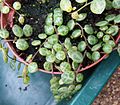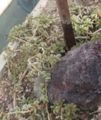Peperomia
| Peperomia {{{latin_name}}}
|
'
| ||||||||||||||||||||||||||||||||||||||||
|---|---|---|---|---|---|---|---|---|---|---|---|---|---|---|---|---|---|---|---|---|---|---|---|---|---|---|---|---|---|---|---|---|---|---|---|---|---|---|---|---|---|

|
|
| |||||||||||||||||||||||||||||||||||||||
| |||||||||||||||||||||||||||||||||||||||||
| Standard Cyclopedia of Horticulture |
|---|
|
Peperomia (Greek, pepper-like). Piperaceae. An enormous genus of tropical and subtropical herbs, including a few small but choice foliage plants for warmhouse, conservatory, or house decoration. Annual, or perenial by a creeping caudex or by tubers formed at the base: sts. prostrate, creeping and thread-like, prostrate, creeping and thread-like,or erect and slender, or short thick,and succulent: lvs. alternate, opposite, or in whorls of 3-4 (rarely 5-6), entire, fleshy or membranous, often with pellucid dots, sometimes attractively veined or colored: fls. minute, usually disposed in a dense spike; stamens 2: anther-cells confluent; stigma sessile, undivided, often tufted: fr. a small or minute berry, 1-seeded,with thin pericarp. —Species perhaps 500 or more, widely dispersed, but mostly in Amer. from Fla. to Chile and Argentina. Very few are cult. The names of peper- omias are much confused, partly owing to the vast size of the genus, which always increases the difficulties of discrimination, and partly to the minuteness of the fls. Moreover, the duration of many kinds is uncertain, while great numbers are monocarpic, that is, they flower and fruit once and then die. In the following account, the names are those that mostly appear in the trade and in horticultural literature; now far these names may be properly determined botanically is a subject for investigation. Peperomias are very attractive and beautiful small- stature glasshouse plants, having particularly a very decorative appearance among other foliage plants. For their general culture they need a warm house. By the end of January they will become active both in root and foliage. From February on they will stand an increase in temperature to about 62° at night; this may be increased until they are having 65° to 70° with an increase of 10° to 15° on bright days. As the sun gets powerful in the spring, they will need shade, or as soon as the foliage shows signs of losing color. In the summer they need a good supply of water, but in autumn and winter they require very careful watering. In spring and summer they profit by frequent light spraying. Keep the atmosphere of the house in a moist state, but avoid a stuffy or stagnant condition. In the slow time of winter, they will stand the temperature to be lowered to about 60 with 10° to 15° increase with sun. Give less spraying and be very careful in giving water during the dark and dull time, otherwise the roots will rot.-f-They can be propagated readily from pieces of the stems or leaves placed in pans of silver sand and plunged where they will have bottom heat of 75° to 80°. Do not cover with glass as it tends to make them rot. Keep shaded and be very careful about watering, and they will soon root. When they make sufficient roots, they may be potted up into small pots, using loam four parts, fibrous peat two parts, ana enough sand to keep it open. For larger shifts, use a more lumpy mixture of fibrous loam, fibrous peat, and well-decayed cow-manure. By July or August they should get their last shift, until the coming of spring. They will stand full sun by the end of September and through the winter, and this greatly aids in keeping them in good condition at that season. In some collections is a plant known as P. crassifolia (which is probably not P. crassifolia. Baker, of Trop. Afr.). It is a very distinct species with dark green, ovate, fleshy lvs. 3x5 in., becoming very hard when old: sts. branched and upright in habit, a foot in height: fls : insignificant catkins. It ia a very good plant and deserve to be more generally known.—P. pubifolia, Veitch. Perennial creeper of unknown habitat, suitable for hanging-baskets. Lvs. small, ovate, marked with a central gray bar.—P. resedaeflora. Andre, intro. in 1865, was "found in all stoves" 2 years later and paid to be "a plant for the million." It differs from all the above in being a flowering plant rather than a foliage plant, for the lvs. are merely bordered lighter green and the fis. are about as showy as those of a mignonette, each one 3—4 lines long, and 100 or so in a raceme, St. 1-1 1/2 ft. high, red, forked: lvs. broadly ovate, cordate. Colombia. CH
|
Cultivation
- Do you have cultivation info on this plant? Edit this section!
Propagation
- Do you have propagation info on this plant? Edit this section!
Pests and diseases
- Do you have pest and disease info on this plant? Edit this section!
Species
Over 1000, includingwp:
Peperomia acuminata
Peperomia alata
Peperomia caperata
Peperomia clusiaefolia
Peperomia cookiana
Peperomia corcovadensis
Peperomia crassifolia
Peperomia fraseri
Peperomia galioides
Peperomia glabella
Peperomia graveolens
Peperomia griseo-argentea
Peperomia hederaefolia
Peperomia incana
Peperomia johnsonii
Peperomia leptostachya
Peperomia lyman-smithii
Peperomia maculosa
Peperomia maxonii
Peperomia nivalis
Peperomia obtusifolia
Peperomia pellucida
Peperomia prostrata
Peperomia rhombea
Peperomia rotundifolia
Peperomia rubella
Peperomia sandersii
Peperomia tetraphylla
Peperomia urvilleana
Peperomia velutina
See also List of Peperomia species
Gallery
If you have a photo of this plant, please upload it! Plus, there may be other photos available for you to add.
Peperomia incana, a large herb
Peperomia prostrata, a hanging or creeping succulent
Peperomia nivalis ssp./var. crassa, a xerophyte
Peperomia obtusifolia, a small herb
References
- Standard Cyclopedia of Horticulture, by L. H. Bailey, MacMillan Co., 1963
External links
- w:Peperomia. Some of the material on this page may be from Wikipedia, under the Creative Commons license.
- Peperomia QR Code (Size 50, 100, 200, 500)



